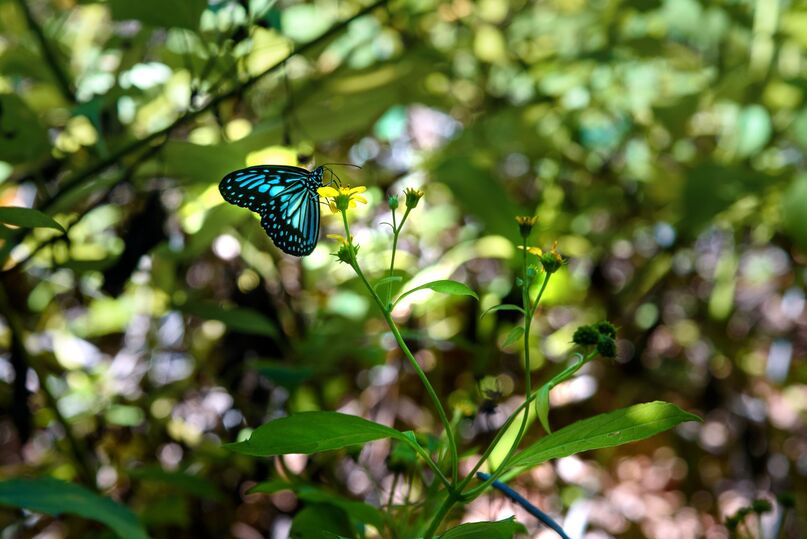Recognizing the importance of sustainable tropical forestry on International Day for Biological Diversity
22 May 2022

A butterfly in Tangkoko National Park, Indonesia. There is no inherent contradiction between biodiversity conservation and a vibrant timber sector—the key is sustainable forestry, which ITTO has been promoting since the 1980s. Photo: E. Odareeva/Pond5
Yokohama, Japan, 22 May 2022: Biodiversity is under threat, with a million species facing extinction. On the International Day for Biological Diversity, it has never been more urgent to enhance the essential role of sustainable forest management (SFM) in safeguarding our precious biota. Read on to learn more about the role ITTO is playing in this essential endeavour in the tropics.
This year’s theme for the International Day for Biological Diversity is, “Building a shared future for all life”, reflecting the importance of nature-based solutions for conserving biodiversity, achieving the Sustainable Development Goals (SDGs) and building back better.
Tropical forests are home to three-quarters of the world’s terrestrial biodiversity. Most of this biodiversity exists outside protected areas and what happens in production forests, therefore, is crucial.
Sustainable forest harvesting in the tropics is often misinterpreted as deforestation and a major threat to biodiversity conservation. To the contrary, however, harvesting wood and forest products from legally and sustainably managed tropical forests is not deforestation. SFM helps conserve biodiversity in productive forest landscapes and generate revenue and employment while respecting social and environmental safeguards. Ensuring the economic and environmental sustainability of forest production is a strategic approach to biodiversity conservation and sustainable development.
“There is no inherent contradiction between biodiversity conservation and a vibrant timber sector—the key is sustainable forest management,” says ITTO Executive Director Sheam Satkuru. “The sustainable use of tropical production forest landscapes is crucial for the future of the world’s biodiversity and for millions of forest-dependent people.”
Since its inception, ITTO has developed policies and funded projects aimed at conserving biodiversity while also creating economic opportunities for forest-dependent people. For example, the Organization worked with the International Union for Conservation of Nature (IUCN) to publish the ITTO/IUCN Guidelines for the Conservation and Sustainable Use of Biodiversity in Tropical Timber Production Forests. The guidelines set out the steps forest managers should take to cost-effectively meet biodiversity conservation goals in production forests while ensuring the full participation of Indigenous Peoples and local communities and respecting and making use of both traditional and scientific knowledge.
In 2010, ITTO and the Convention on Biological Diversity (CBD) established the Joint ITTO–CBD Collaborative Initiative for Tropical Forest Biodiversity with the goal of improving biodiversity conservation in tropical forests by addressing the two main drivers of biodiversity loss in tropical forests—deforestation and forest degradation.
To date, the Collaborative Initiative has encompassed 16 projects in 23 tropical countries. All these countries have experienced forest and biodiversity losses and have large numbers of forest-dependent people. At USD 13 million, the total budget of the 16 projects is modest, but a recent technical review found that they have achieved extraordinary success in improving local livelihoods and forest management, restoring degraded forest landscapes and conserving biodiversity. Notable achievements include increasing the size of a mangrove protected area in Peru by more than 700 000 ha; providing more than 400 foresters and technicians in Central Africa with education and training on SFM; enabling previously difficult transboundary cooperation in the Emerald Triangle between Cambodia and Thailand; and restoring 130 ha of mangroves in Fiji.
The collaboration between ITTO and the CBD has contributed to several Aichi Biodiversity Targets, specifically Target 1 on awareness-raising, Target 5 on reducing habitat loss, Target 7 on SFM, Target 11 on protected-area management, Target 12 on the protection of endangered species, and Target 14 on restoring and safeguarding ecosystem services. The Collaborative Initiative has also contributed to many of the SDGs.
ITTO’s work to encourage sustainable forestry in the tropics is having various positive impacts on biodiversity conservation. For example, two ongoing forest fire initiatives in Peru and Indonesia are tackling the threat of wildfires through improved fire prevention and firefighting capacity, the development of early-response protocols, and increasing public awareness. This, in turn, will benefit biodiversity conservation, especially conservation of wildlife and natural habitats.
ITTO is also piloting a programme line focused on enhancing biodiversity and ecosystem services in tropical production forest landscapes while maintaining sustainable timber production. There is considerable evidence to suggest that sustainably managed forests used for timber production constitute a major resource for biodiversity conservation. Indeed, it is crucial that they do.